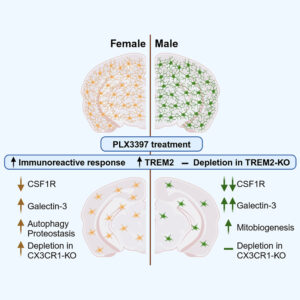I sometimes make fun of microglia, because they were (unfairly) given a name that means “tiny glue.” They deserve better: these are immune cells that live in the brain and attend to numerous important matters (none of which involve glue). A new paper in Cell Reports shows that microglia in mice are strikingly different between males and females, and for me this adds to their mystique as quiet heroes of the brain and to the pathos of their silly name.

So, what is strikingly different? PLX3397 is an inhibitor of the CSF1 receptor, but what matters to us mere mortals is that its action causes loss of microglia from a treated brain. The drug is used widely to erase microglia, facilitating subsequent experimental manipulations. The authors show that its effects differ based on sex and that the difference is likely connected to very different actions of the surviving microglia: in males, the survivors make more mitochondria; in females, the survivors invest in protein retention and recycling (proteostasis and autophagy). As the authors conclude in their abstract: “These findings suggest sex-dependent microglial survival mechanisms, which might contribute to the well-documented sex differences in various neurological disorders.” That is an interesting and important result. But one more thing. The title was, I think, written for specialists who know a lot about CSF1 and who know what PLX3397 does. Those excluded from this company discover the key difference at the end of the title, which (please humor me) could have been “Sex differences in microglia are revealed by differential response to inhibition of Colony-stimulating factor.” Just a thought.
The microglial response to inhibition of Colony-stimulating-factor-1 receptor by PLX3397 differs by sex in adult mice
In Cell Reports, 25 January 2025
From the lab of Ania K. Majewska.
Snippet by Stephen Matheson
Image credit: graphical abstract from Le et al. linked above (CC-BY-NC-ND)